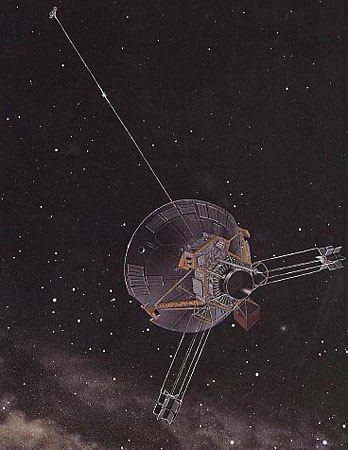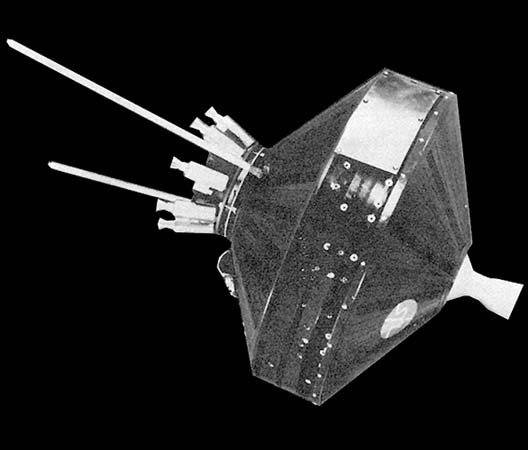Pioneer
space probes

 any of the first series of unmanned U.S. space probes designed chiefly for interplanetary study. Whereas the first five Pioneers (0–4) were intended to explore the vicinity of the moon, all other probes in the series were sent to investigate planetary bodies or to measure various interplanetary-particle and magnetic-field effects. Pioneer 6 (launched 1965), for example, was injected into solar orbit to determine space conditions between Earth and Venus. It transmitted much data on the solar wind and solar cosmic rays (cosmic ray) in addition to measuring the Sun's (Sun) corona and the tail of Comet Kohoutek. Pioneer 10 (1972) flew by Jupiter in December 1973, the first space probe to do so, and discovered its huge magnetic tail, an extension of the planet's magnetosphere. Pioneer 11 (1973), also called Pioneer- Saturn, passed by Jupiter in December 1974 and flew within about 20,900 km (13,000 miles) of Saturn in September 1979. It transmitted data and photographs that enabled scientists on Earth to identify two additional rings around the planet and the presence of radiation belts within its magnetosphere. Pioneers 10 and 11 each carried a gold plaque inscribed with a pictorial message in the event that extraterrestrial beings ever found the spacecraft. Two complementary Pioneer Venus spacecraft (Pioneer 12 and 13; 1978) reached their destination at the end of 1978. The first, called the Orbiter, studied Venus's clouds and atmosphere and mapped more than 90 percent of its surface by radar. The second spacecraft, the Multiprobe, dropped one large and three small instrument packages into the planet's atmosphere at different locations to measure various physical and chemical properties.
any of the first series of unmanned U.S. space probes designed chiefly for interplanetary study. Whereas the first five Pioneers (0–4) were intended to explore the vicinity of the moon, all other probes in the series were sent to investigate planetary bodies or to measure various interplanetary-particle and magnetic-field effects. Pioneer 6 (launched 1965), for example, was injected into solar orbit to determine space conditions between Earth and Venus. It transmitted much data on the solar wind and solar cosmic rays (cosmic ray) in addition to measuring the Sun's (Sun) corona and the tail of Comet Kohoutek. Pioneer 10 (1972) flew by Jupiter in December 1973, the first space probe to do so, and discovered its huge magnetic tail, an extension of the planet's magnetosphere. Pioneer 11 (1973), also called Pioneer- Saturn, passed by Jupiter in December 1974 and flew within about 20,900 km (13,000 miles) of Saturn in September 1979. It transmitted data and photographs that enabled scientists on Earth to identify two additional rings around the planet and the presence of radiation belts within its magnetosphere. Pioneers 10 and 11 each carried a gold plaque inscribed with a pictorial message in the event that extraterrestrial beings ever found the spacecraft. Two complementary Pioneer Venus spacecraft (Pioneer 12 and 13; 1978) reached their destination at the end of 1978. The first, called the Orbiter, studied Venus's clouds and atmosphere and mapped more than 90 percent of its surface by radar. The second spacecraft, the Multiprobe, dropped one large and three small instrument packages into the planet's atmosphere at different locations to measure various physical and chemical properties.- Pará River
- Paráskhos, Akhilléfs
- Paré, Ambroise
- Parākramabāhu I
- Pasadena
- Pasadena Playhouse
- Pa Sak River
- Pasargadae
- Pasay
- Pascagoula
- Pascal
- pascal
- Pascal, Blaise
- Pascaline
- Pascal's principle
- Paschal controversies
- Paschal (I)
- Paschal II
- Paschal (III)
- Paschal I, Saint
- Paschal lamb
- Paschasius Radbertus, Saint
- Pascin, Jules
- Pasco
- Pascoli, Giovanni